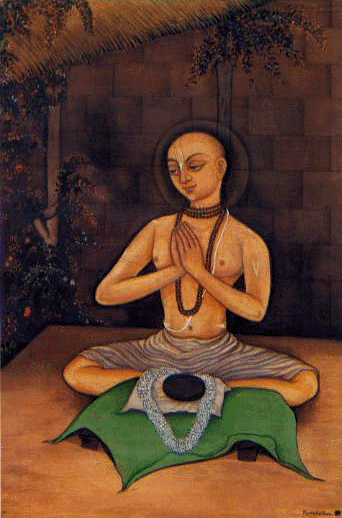
by Shrila Gopala Bhatta Gosvami
APPENDIX II
Add Vishnu smaranam and details on sankalpa (names of the years, nakshatras etc.)
The Common Rites
The night before the samskara proper, one begins with the establishment of the ghata, Vishnu puja, and adhivasa. The next morning, one should recite the Svasti Vacana, Sankalpa, establish the ghata, worship Lord Vishnu, worship the parampara acaryas (Sattvika Vriddhi Shraddha), and perform Cediraja Puja (Vasudhara).
Svasti Vacana
@ TRANS from Pratistha Vidhi book
Three brahmanas should chant:
om punantu mam devajanah
punantu manasa dhiyah
punantu vishva bhutani
jatavedah punihi mam
One brahmana chants:
om asya karmanah punyaham bhavanto bhruvantu
At least three brahmanas throw akshata in the air three times, while chanting:
om punyaham om punyaham om punyaham
Together they chant:
om udgat eva shakune sama gayasi
brahma putra iva savaneshu samshasi
vrisheva vaji shishumatirapitya
sarvato nah shakune bhadrama vada
vishvato nah shakune punyama vada
One brahmana chants:
om asya karmanah svasti bhavanto bhruvantu ayushmate svasti
The brahmanas throw akshata in the air three times, while chanting:
om svasti om svasti om svasti
Together:
om svasti na indro vriddhashravah
svasti nah pusha vishvavedah
svasti nas tarkshyo arishtanemih
svasti no brihaspatih dadhatu
One brahmana chants:
om asya karmana riddhim bhavanto bhruvantu
The brahmanas throw akshata in the air three times, while chanting:
om ridhyatam om ridhyatam om ridhyatam
Together:
om ridhyama stomam sanuyama vaja ma no
mantram sara thehopa yatam
yasho na pakvam madhu goshvanta ra
bhutamso ashvinoh kamamaprah
om svasti no govindah
svasti no ‘cyutanantau
svasti no vasudevo vishnur dadhatu
svasti no narayana naro vai
svasti nah padmanabhah purushottamo dadhatu
svasti no vishvakseno vishveshvarah
svasti no hrishikesho harir dadhatu
svasti no vainateyo harih
svasti no ‘njanasuto hanur bhagavato dadhatu
svasti svasti sumangalaikesho mahan
shri krishnah saccidananda ghanah sarveshvareshvaro dadhatu
The brahmanas should throw the remainder of the akshata.
The mangalacarana prayers may be recited at this point.
Sankalpa
Sankalpa should be performed using a small copper vessel. Silver, stone, clay, conch or bell metal should not be used, nor should sankalpa be performed using only the hands. One should fill the pot with water, and add sesame, three blades of kusha (with root and tip intact), flowers, and haritaki or banana.
One should chant the sankalpa:
om vishnur
om tat sat
adya
_______mase (lunar month )
_______pakshe ( lunar fortnight)
_______tithau (lunar day)
acyuta gotrah
(name of sponsor) dasa
(name of function) karmabhuyadayartham
shri krishna prityartham
shri bhagavatarcana vasudhara sampatanayusha sukta japabhyudaika shraddha
karmamyaham karishye
@translation:
One should then throw some of the water in the North-East direction, pour the balance water on the ground (or into a visarjana patra placed on the floor) turn the vessel upside down and place gandha and pushpa on it.
Then recite Sama Vediya Sankalpa Sukta
om devo vo dravinodah purnam vivashtvasicam
udhva sincadhva mupa va prinadhva deva uhate
om sankalpitarithasya siddhirastu
@translation:
Ghata Sthapana
The ghata or water pot, by assembling with the proper mantras and calling in the Lord, becomes a form of the Lord which can be worshipped with upacaras (articles such as foot wash, arghya, lamps etc.) in the manner that one worships a murti.
The ghata (pot) may be made of gold, silver, copper, bell metal, stone or clay. Those made of clay are suitable for all purposes, but should be unbroken, clean and should only be used once.
One should place either nava-ratna (pearl, cat’s eye, gomed, diamond, coral, yellow sapphire, emerald, blue sapphire, ruby), panca-ratna (pearl, cat’s seye, diamond, sapphire, ruby), or a piece of gold in the water within the pot.
The leaves used may be banyan, pippal, mango, or udumbara. Mango leaves are the most commonly used.
The fruit is usually coconut (green, with stem; or ripened with tuft), but banana may also be used.
The ghata should be established in the North-East part of the mandapa, or East of the fire pit. one may draw an eight petalled lotus on the ground using five colored dyes (white, red, yellow, black and green) with paddy in the centre and place the ghata on top of the grains.
Leave a Reply